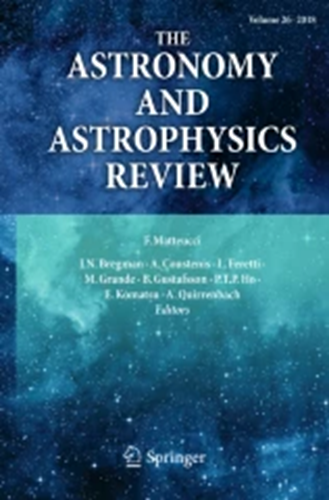Orbital eccentricities as indicators of stellar populations. II. Vertical velocity distribution from the Gaia DR2 catalogue
IF 26.5
1区 物理与天体物理
Q1 ASTRONOMY & ASTROPHYSICS
引用次数: 0
Abstract
Context. In previous work, we showed how the planar and vertical eccentricities of disc stars, e and e′, could be used as indicators of the stars’ kinematic populations. For a local stellar sample drawn from the Gaia DR2 catalogue, these populations were represented geometrically in the eccentricity diagram, e′2 vs. e2, approximately separated by straight lines. Aims. In the current work, we propose a new relationship between the star’s perpendicular velocity and its vertical eccentricity, allowing for a reevaluation of the critical vertical eccentricity and maximum height, zmax, specific to each population component. Methods. We approximated the local potential function to be consistent with the actual shape of the curve that relates the maximum vertical speed of a star and its maximum height. The curve corresponds to a non-linear restoring vertical force, where the stiffness decreases with an increase in the maximum height. The constants involved in this fitting, together with the population velocity dispersions, determine the specific region for each population in the eccentricity diagram. Results. The new classification determines 88% of the sample is made up of thin disc stars and 9% of thick disc stars, whereby 3% of the stars have been relabelled, by providing thinner thin and thick discs. Nested thin disc subsamples allow us to estimate Strömberg’s asymmetric drift equation, leading to a heliocentric velocity of the circular orbit of Vc ≈ −12.9 km s−1, an absolute rotation velocity of Θc ≈ 227 km s−1, and a rotation component of the Galactocentric velocity of the Sun at Θ ≈ 240 km s−1. Conclusions. The thin disc stars of our local sample are characterised based on values 0 ≤ e ≤ 0.32, 0 ≤ e′ ≤ 0.09, and zmax = 0.7 kpc. Disc stars satisfy 0 ≤ e ≤ 0.44, 0 ≤ e′ ≤ 0.18, zmax = 1.5 kpc. The maximum vertical peculiar velocity for disc stars is found to be w0 = 115 km s−1. The assumed potential provides a stellar density of the disc vanishing at z0 = 1.8 kpc. The approximate behaviour in the local disc is that a small decrease in the stiffness is associated with a relative decrease in the limiting velocity, which produces a thinner disc and a loss of stars in the local cylinder, both in a similar proportion to the limiting velocity.轨道偏心率作为恒星群的指示器。2盖亚DR2星表的垂直速度分布
上下文。在之前的工作中,我们展示了盘状恒星的平面和垂直偏心率e和e '可以作为恒星运动种群的指标。对于从盖亚DR2星表中提取的一个本地恒星样本,这些恒星群在偏心率图中以几何方式表示,e ' 2对e2,大约用直线分开。目标在目前的工作中,我们提出了恒星垂直速度与其垂直偏心率之间的新关系,允许重新评估临界垂直偏心率和最大高度zmax,具体到每个人口组成部分。方法。我们将局部势函数近似为与恒星的最大垂直速度与其最大高度相关的曲线的实际形状一致。该曲线对应于非线性恢复垂直力,其中刚度随着最大高度的增加而减小。这种拟合所涉及的常数,连同种群速度的分散,决定了偏心图中每个种群的特定区域。结果。新的分类确定了88%的样本由薄盘星和9%的厚盘星组成,其中3%的恒星通过提供更薄的薄盘和厚盘被重新标记。嵌套的薄圆盘子样本使我们能够估计Strömberg的不对称漂移方程,从而得出Vc圆轨道的日心速度≈−12.9 km s−1,绝对自转速度Θc≈227 km s−1,以及太阳的银河系中心速度的旋转分量Θ≈240 km s−1。结论。我们本地样本的薄盘星的特征值为0≤e≤0.32,0≤e′≤0.09,zmax = 0.7 kpc。盘星满足0≤e≤0.44,0≤e′≤0.18,zmax = 1.5 kpc。盘状恒星的最大垂直特殊速度为w0 = 115 km s−1。假设的势能提供了在z0 = 1.8 kpc处消失的星盘密度。在局部圆盘上的近似行为是,刚度的小幅下降与极限速度的相对下降有关,这会产生更薄的圆盘和局部圆柱体中恒星的损失,两者与极限速度的比例相似。
本文章由计算机程序翻译,如有差异,请以英文原文为准。
求助全文
约1分钟内获得全文
求助全文
来源期刊

The Astronomy and Astrophysics Review
地学天文-天文与天体物理
CiteScore
45.00
自引率
0.80%
发文量
7
期刊介绍:
The Astronomy and Astrophysics Review is a journal that covers all areas of astronomy and astrophysics. It includes subjects related to other fields such as laboratory or particle physics, cosmic ray physics, studies in the solar system, astrobiology, instrumentation, and computational and statistical methods with specific astronomical applications. The frequency of review articles depends on the level of activity in different areas. The journal focuses on publishing review articles that are scientifically rigorous and easily comprehensible. These articles serve as a valuable resource for scientists, students, researchers, and lecturers who want to explore new or unfamiliar fields. The journal is abstracted and indexed in various databases including the Astrophysics Data System (ADS), BFI List, CNKI, CNPIEC, Current Contents/Physical, Chemical and Earth Sciences, Dimensions, EBSCO Academic Search, EI Compendex, Japanese Science and Technology, and more.
 求助内容:
求助内容: 应助结果提醒方式:
应助结果提醒方式:


